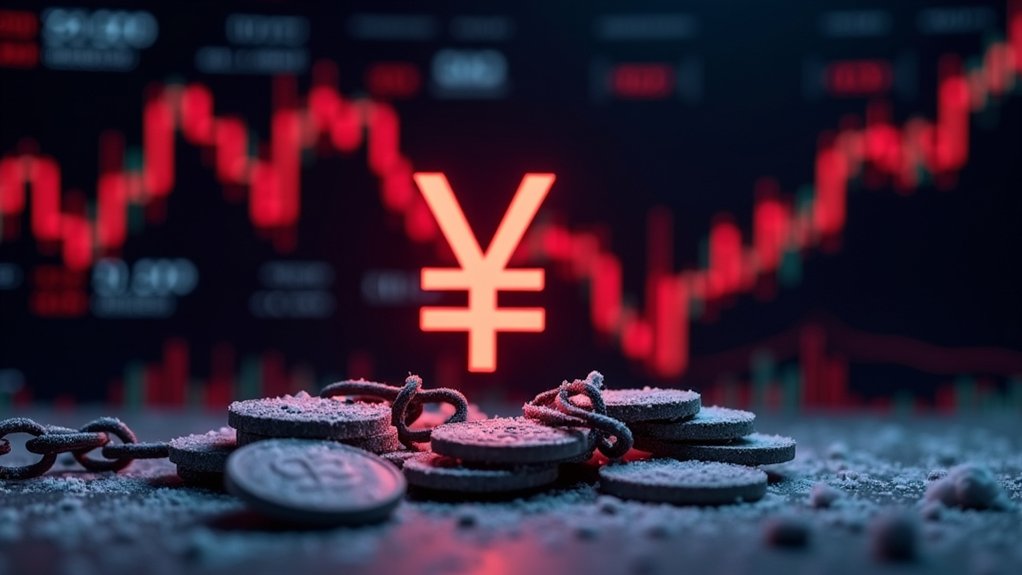Cryptocurrency trading happens on digital exchanges where buyers and sellers meet to trade digital coins. There are two main types: centralized exchanges like Binance that work like traditional stock markets, and decentralized exchanges that connect traders directly. Traders can place different kinds of orders, from simple market buys to complex limit orders. Some traders make quick daily trades, while others hold for longer periods. The world of crypto trading offers multiple strategies and approaches to explore.
Quick Overview
- Cryptocurrency can be traded on centralized exchanges like Binance or decentralized exchanges, each requiring different setup processes and verification levels.
- Market orders provide immediate trades at current prices, while limit orders let you set specific buy/sell prices.
- Choose between day trading for short-term gains, swing trading for medium-term profits, or HODL strategy for long-term investment.
- Protect investments by using stop-loss orders, diversifying across multiple cryptocurrencies, and keeping assets in secure digital wallets.
- Start with small investments while learning to analyze market trends, news, and technical indicators before making trading decisions.

The world of cryptocurrency trading operates through specialized digital marketplaces called exchanges. These platforms come in two main types: centralized exchanges (CEX) like Binance and Coinbase, which work similarly to traditional stock exchanges, and decentralized exchanges (DEX) that don’t need intermediaries to function. Since cryptocurrencies are decentralized digital currency, transactions occur through peer-to-peer networks without central authority oversight. Both types use order book systems that match people who want to buy crypto with those who want to sell it. Traders must complete a Know-Your-Customer verification process before they can start trading on centralized exchanges. Wire transfers are often preferred for funding accounts due to their minimal fees.
Traders can buy and sell crypto using different types of orders. Market orders let them buy or sell right away at the current price, while limit orders allow them to set specific prices they’re willing to pay or accept. Stop-loss orders work like a safety net, automatically selling when prices drop to a certain level to prevent big losses. Some traders use leverage, which lets them trade with borrowed money to potentially make bigger profits, though this also means they could lose more.
Different trading styles suit different people. Day traders make multiple trades within a single day, trying to profit from small price changes. Swing traders hold their positions longer, usually days or weeks, to catch bigger price movements. Then there’s the HODL strategy (a misspelling of “hold” that stuck), where people buy crypto and keep it for months or years, believing its value will increase over time. Some traders use dollar-cost averaging, buying fixed amounts regularly regardless of price.
Trading crypto involves managing risks. Successful traders often spread their money across different cryptocurrencies instead of putting everything into one. They use stop-loss orders to limit potential losses and carefully decide how much money to put into each trade based on their total account balance. Many keep most of their crypto in cold storage, which means storing it offline where hackers can’t reach it. Most exchanges allow users to transfer their cryptocurrency assets to personal digital wallets for added security.
Price differences between exchanges create opportunities for arbitrage, where traders buy crypto on one exchange and sell it on another for a higher price. Some traders use technical analysis, studying price charts and indicators to try to predict where prices might go next. They also stay updated on crypto news and regulations, as these can affect prices quickly.
Whether someone’s trading strategy is simple or complex, understanding how exchanges work and managing risks are key parts of crypto trading.
Frequently Asked Questions
Can I Trade Cryptocurrency Without Internet Access?
Yes, cryptocurrency can be traded without internet through several offline methods.
People can use SMS text messages, radio waves, or mesh networks to send crypto transactions. Special devices like GoTenna nodes ($200) or satellite systems help make this possible.
While offline trading works, it’s not as common as online trading and needs specific equipment. Most offline transactions will still need internet eventually to be recorded on the blockchain.
What Happens to My Crypto if the Exchange Platform Crashes?
If a crypto exchange crashes, several things can happen to stored assets.
The platform might freeze all accounts, stopping users from withdrawing their funds.
If the exchange declares bankruptcy, customers typically become unsecured creditors and must wait for legal proceedings to resolve.
Users might get some or none of their money back.
The recovery process can last months or years.
That’s why many traders don’t keep all their crypto on exchanges.
Is Cryptocurrency Trading Legal in My Country?
Without knowing which country is being asked about, it’s not possible to give a specific answer.
Cryptocurrency’s legal status varies widely around the world. In some places, it’s completely legal and regulated. In others, it’s banned.
Many countries fall somewhere in between – they might allow trading but have restrictions on using crypto as payment.
The rules are also changing frequently as governments update their policies on digital currencies.
How Are Cryptocurrency Gains Taxed in Different Countries?
Crypto tax rules vary widely around the world.
Some countries like China have banned crypto completely.
In the US, traders pay regular income tax rates on short-term gains and lower rates on long-term gains.
Many European nations charge between 15-30% on crypto profits.
There are also tax-free zones like Belarus, Singapore, and Portugal where crypto gains aren’t taxed at all.
Some places only tax crypto if it’s a business activity.
Can I Recover My Cryptocurrency if I Forget My Wallet Password?
Recovering cryptocurrency with a forgotten wallet password depends on having a backup recovery phrase. This phrase is a set of 12-24 words that’s created when the wallet is first set up.
If someone has their recovery phrase, they can restore their wallet and set a new password. Without this phrase, there’s no central authority to help, and the funds could be permanently lost.
Some people try password cracking software or professional recovery services.





